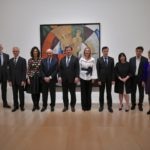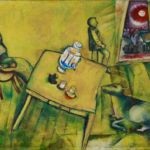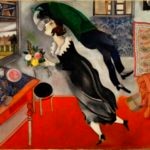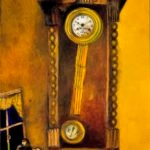Chagall’s breakthrough years, on display at the Guggenheim Museum Bilbao
The Guggenheim Museum Bilbao opens "Chagall. The Breakthrough Years, 1911-1919," sponsored by the BBVA Foundation. The exhibition, which runs through September 2, consists of more than 80 early paintings and drawings by the Russian-born French artist.

Born in 1887 into a Jewish family in the small Belarusian town of Vitebsk, Moishe Segal - later known as Marc Chagall - grew up in an environment where access to Russian culture and art was limited by his own community and the government policy of marginalizing Jews in ghettos and denying them basic rights.
Chagall, moved by his young and rebellious spirit, refused to accept the fate of becoming a laborer and secured a place in his hometown's art school, where he completed his studies before moving to St. Petersburg, a major city which Jews could only enter with a special permit.
A supernatural painter
However, the decisive turning point for Marc Chagall came in 1911. He moved from St. Petersburg to Paris, where he discovered not only the creativity of the avant-garde movements, but also the work of the great masters hanging on the walls of the Louvre. The contrast between the Russia of the tsars and the bohemian art capital inspired his works during this era. Between 1911 and 1914 he produced works that combined popular Russian art and his own family’s heritage, with the experimental inspired by the works of Pablo Picasso, Robert and Sonia Dalaunay and Jacques Lipchitz.
"Impressionism and Cubism are foreign to me," Chagall said before befriending the Delaunays and becoming one of the poet Guillaume Apollinaire's favorite artists, who described the young Belarusian as a "supernatural painter".
The works on display in the first room of the recently opened exhibition all belong to this era, marked by his experiments with colors, abstract and geometrical shapes: 'The yellow room', 'I and my village' or 'Paris through the window', a painting in which he blended his perception of the French capital with images and memories of his native Vitebsk.

The Yellow Room, 1911. Fondation Beyeler, Riehen/Basel, Ernst and Hildy Beyeler Collection © Marc Chagall, Vegap, Bilbao 2018
Lying between two worlds
In 1914, Chagall returned home to attend his sister's wedding and visit his fiancée Bella Rosenfeld. The outbreak of World War I found him in Vitebsk and left him trapped in Russia for eight long years.
"I am lying between two worlds and I look out the window," said the artist about this stage of his life, in which he went through a period of soul-searching. While in paintings such as 'Soldiers' or ‘Departure for war' – showcased in the second room of the exhibition – Chagall reflected the ravages of war, he also painted self-portraits and scenes of the everyday life of his family and community.

Birthday, 1915. The Museum of Modern Art, New York. © Marc Chagall, Vegap, Bilbao 2018
During the Great War a large number of Jews, accused of collaborationism by the government of Czarist Russia, were displaced from their homes and sent to the front line. In the midst of this international conflict, Marc Chagall revisited themes related to his own identity and the folklore and the culture of his people.
These paintings are an example of what Chagall called “documents”, because he did not paint them from memory, as in Paris, but instead painted “what I had before my eyes. I painted looking out the window, I never went for a walk carrying my paint box with me," as Chagall later recalled in his autobiography (My Life).
He painted everything, from a newspaper vendor and beggar, to a clock or a mirror, to which he added meaning-laden objects such as tefillin (a set of leather boxes containing scrolls inscribed with verses from the sacred Hebrew scriptures, that observant adult Jews tie to their head or arms during prayer) or texts in Yiddish, Hebrew or Cyrillic.

Clock, 1914. Tretyakov Gallery, Moscow © Marc Chagall, Vegap, Bilbao 2018
Some of his most important works from this period are the Jews in green, red, and black and white, mistakenly known as the “Four Great Rabbis.” The Guggenheim exhibition offers a rare occasion to see the entire series, since the 'Red Jew' usually hangs in the State Museum of St. Petersburg, Russia, while the other three pieces of the ensemble are at the Kunstmuseum Basel on long-term loan.
The journey through these "breakthrough years" of Chagall’s work concludes with a series of paintings and drawings belonging to an era that began with the Russian Revolution of 1917. After the fall of the Czarist regime, Jewish upper-class citizens and intellectuals were gradually granted some of the freedoms they had hitherto been denied. Chagall himself - who played an active role in the revolution – was appointed Commissar of Arts for Vitebsk, where he founded the People’s Art School.
However, disenchanted with the course the Bolshevik revolution started to take and after problems with the party bureaucracy, Chagall soon withdrew from the project and abandoned Vitebsk. Two years later, he left Russia, never to return, and settled back in Paris, bringing to a close this decisive phase of his life showcased in this BBVA Foundation sponsored exhibition.